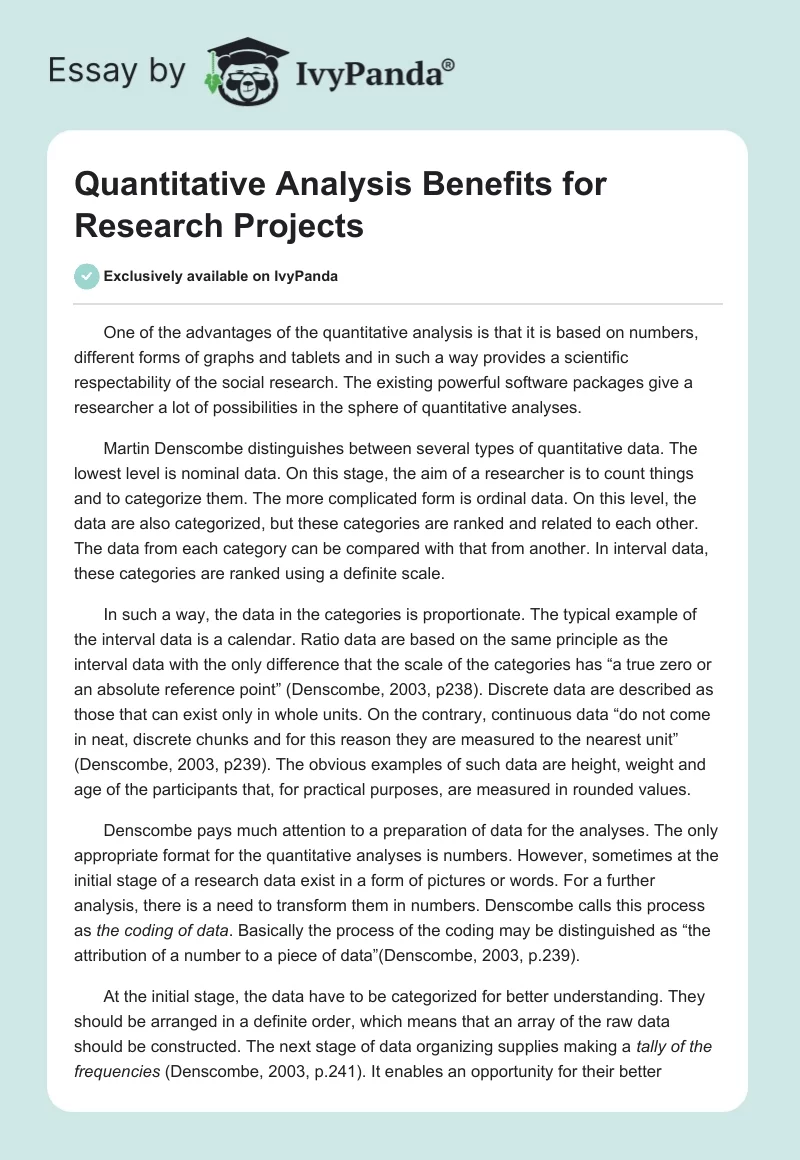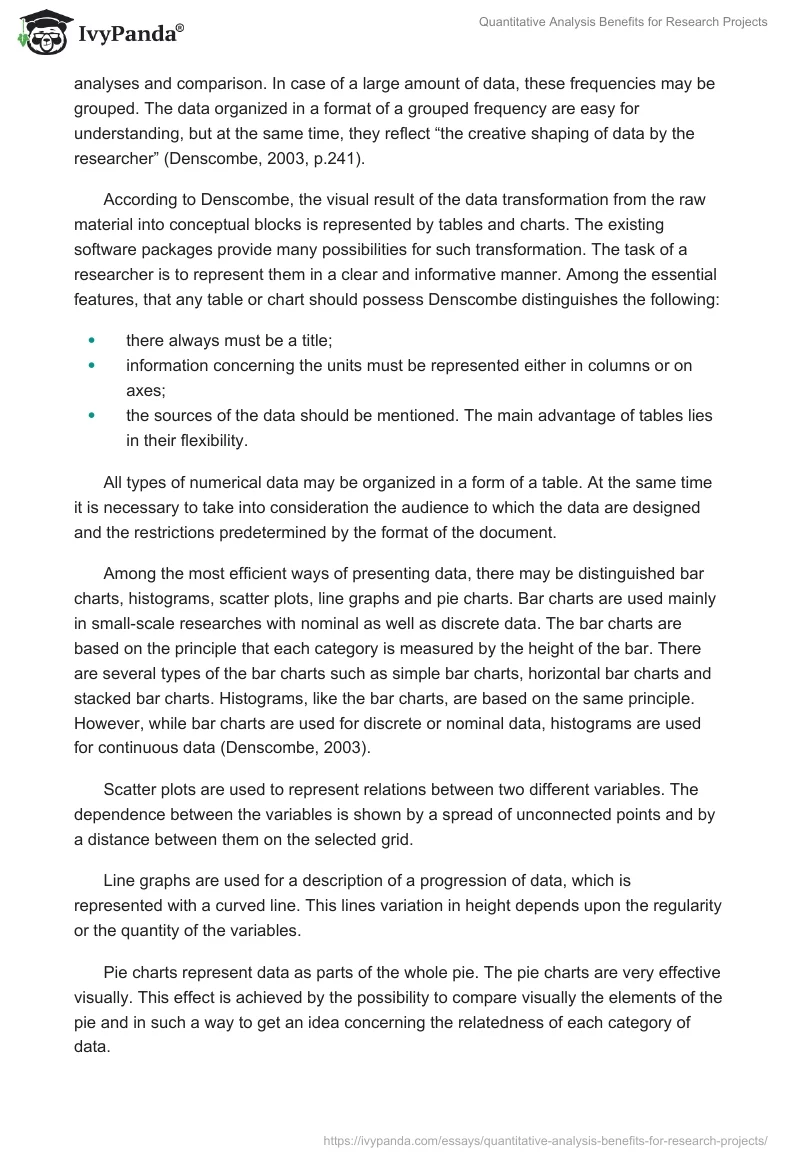One of the advantages of the quantitative analysis is that it is based on numbers, different forms of graphs and tablets and in such a way provides a scientific respectability of the social research. The existing powerful software packages give a researcher a lot of possibilities in the sphere of quantitative analyses.
Martin Denscombe distinguishes between several types of quantitative data. The lowest level is nominal data. On this stage, the aim of a researcher is to count things and to categorize them. The more complicated form is ordinal data. On this level, the data are also categorized, but these categories are ranked and related to each other. The data from each category can be compared with that from another. In interval data, these categories are ranked using a definite scale.
In such a way, the data in the categories is proportionate. The typical example of the interval data is a calendar. Ratio data are based on the same principle as the interval data with the only difference that the scale of the categories has “a true zero or an absolute reference point” (Denscombe, 2003, p238). Discrete data are described as those that can exist only in whole units. On the contrary, continuous data “do not come in neat, discrete chunks and for this reason they are measured to the nearest unit” (Denscombe, 2003, p239). The obvious examples of such data are height, weight and age of the participants that, for practical purposes, are measured in rounded values.
Denscombe pays much attention to a preparation of data for the analyses. The only appropriate format for the quantitative analyses is numbers. However, sometimes at the initial stage of a research data exist in a form of pictures or words. For a further analysis, there is a need to transform them in numbers. Denscombe calls this process as the coding of data. Basically the process of the coding may be distinguished as “the attribution of a number to a piece of data”(Denscombe, 2003, p.239).
At the initial stage, the data have to be categorized for better understanding. They should be arranged in a definite order, which means that an array of the raw data should be constructed. The next stage of data organizing supplies making a tally of the frequencies (Denscombe, 2003, p.241). It enables an opportunity for their better analyses and comparison. In case of a large amount of data, these frequencies may be grouped. The data organized in a format of a grouped frequency are easy for understanding, but at the same time, they reflect “the creative shaping of data by the researcher” (Denscombe, 2003, p.241).
According to Denscombe, the visual result of the data transformation from the raw material into conceptual blocks is represented by tables and charts. The existing software packages provide many possibilities for such transformation. The task of a researcher is to represent them in a clear and informative manner. Among the essential features, that any table or chart should possess Denscombe distinguishes the following:
- there always must be a title;
- information concerning the units must be represented either in columns or on axes;
- the sources of the data should be mentioned. The main advantage of tables lies in their flexibility.
All types of numerical data may be organized in a form of a table. At the same time it is necessary to take into consideration the audience to which the data are designed and the restrictions predetermined by the format of the document.
Among the most efficient ways of presenting data, there may be distinguished bar charts, histograms, scatter plots, line graphs and pie charts. Bar charts are used mainly in small-scale researches with nominal as well as discrete data. The bar charts are based on the principle that each category is measured by the height of the bar. There are several types of the bar charts such as simple bar charts, horizontal bar charts and stacked bar charts. Histograms, like the bar charts, are based on the same principle. However, while bar charts are used for discrete or nominal data, histograms are used for continuous data (Denscombe, 2003).
Scatter plots are used to represent relations between two different variables. The dependence between the variables is shown by a spread of unconnected points and by a distance between them on the selected grid.
Line graphs are used for a description of a progression of data, which is represented with a curved line. This lines variation in height depends upon the regularity or the quantity of the variables.
Pie charts represent data as parts of the whole pie. The pie charts are very effective visually. This effect is achieved by the possibility to compare visually the elements of the pie and in such a way to get an idea concerning the relatedness of each category of data.
While given definition to the mid-point in amount of data, Denscombe distinguishes between three types of averages. They are “the mean, the median and the mode” (Denscombe, 2003, p.252). The mean is the result of the equal distribution of values. The median is a mid-point between two values. The mode is the most common value in the range of data.
Quantitative data analyses has its benefits as well as its own disadvantages. Among its advantages, it is possible to mention its scientific nature, the confidence and the effective way of data presentation. At the same time, a large amount of data and an overuse of different techniques of analyses may be dangerous for the quality of data. Denscombe states that “quantitative analysis is not as scientifically objective as it might seem on the surface” (Denscombe, 2003, p.265).
Reference List
Denscombe, M. (2003). The Good Research Guide for small-scale social research projects. Philadelphia: Open University Press. Web.


